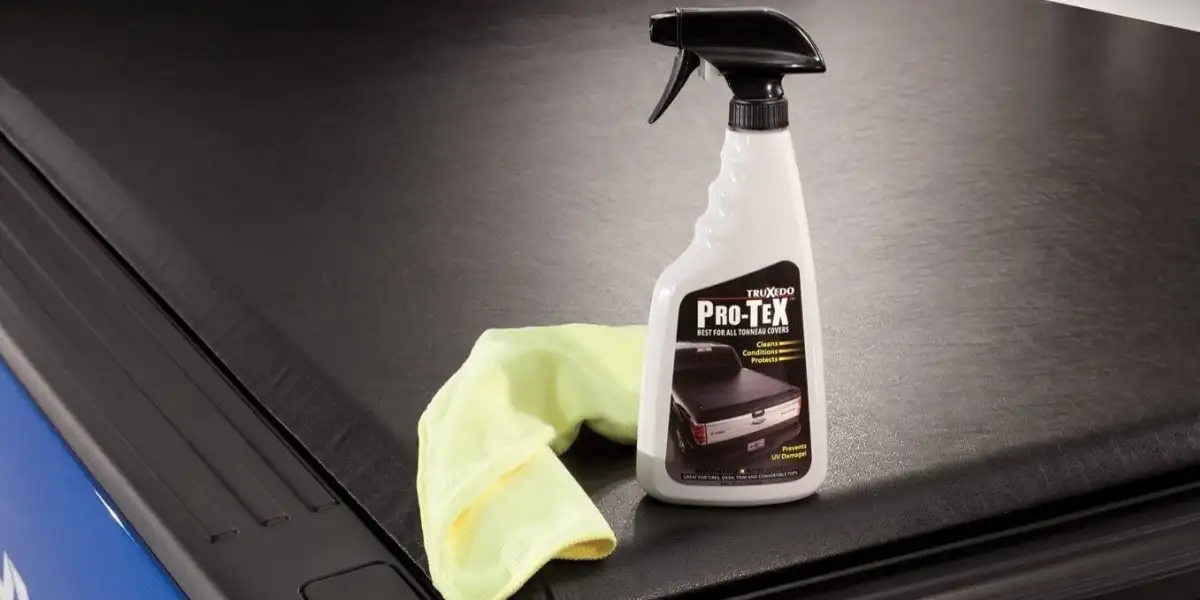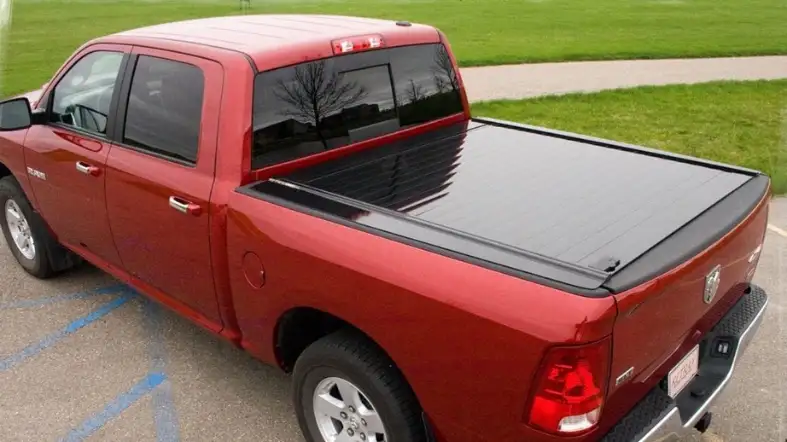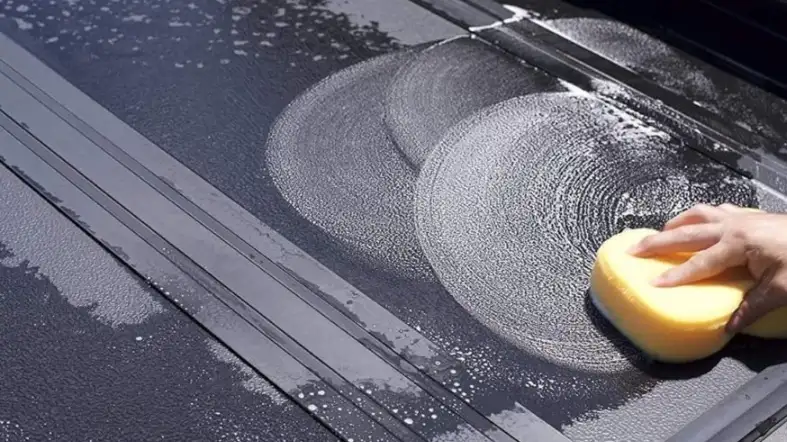Are you wondering how to effectively clean and protect your tonneau cover?
Discover the key to maintaining the longevity and appearance of your truck bed cover.
From regular cleaning routines to essential products, this article reveals everything you need to know.
The secrets of optimal tonneau cover maintenance can help you say goodbye to dirt, grime, and potential damage.

What to Use to Clean and Protect Tonneau Cover?
To clean and protect your tonneau cover, use a mild soap or detergent, a soft brush or cloth, and water. Avoid harsh chemicals, abrasive cleaners, and stiff brushes that can damage the cover.
Apply a vinyl or fabric protectant to shield it from UV rays and maintain its appearance.
Best Practices for Cleaning Your Tonneau Cover
Cleaning your tonneau cover is essential to maintain its appearance and functionality.
Follow these best practices to ensure a thorough and effective cleaning process.
Gather the necessary supplies
To begin, collect the supplies you’ll need for the cleaning task. Microfiber cloth and a bucket of warm water, as well as a mild detergent, are needed.
Having these items readily available will make the cleaning process more efficient.
Remove any debris
Before cleaning your tonneau cover, remove any loose debris or dirt from its surface. Gently sweep or shake off dust, leaves, or other particles with a broom or brush.
This step will prevent scratching the cover during the cleaning process.
Prepare the cleaning solution
Ensure that the detergent you use on your tonneau cover is suitable for use in a bucket of warm water.
Thoroughly mix the detergent with the water to create a soapy solution. Avoid using harsh chemicals or abrasive cleaners that can damage the cover.
Clean the tonneau cover
Brush or sponge the tonneau and cover gently with the soapy solution. Start from one end and work your way to the other, covering the entire surface.
Give extra care and attention to stains, bird droppings, and stubborn dirt spots.
Rinse with clean water
After cleaning the tonneau cover, rinse it thoroughly with clean water. Use a hose or a bucket of fresh water to remove all traces of soap from the surface.
Ensure that the water pressure is not too high, as it may cause damage. A gentle flow of water is sufficient to wash away the soap residue.
Dry the tonneau cover
Once you have rinsed off the soap, use a microfiber cloth to dry the tonneau cover. Gently wipe the surface, removing any excess water.
Pay special attention to seams, creases, and corners to prevent moisture buildup. Leaving the cover wet can lead to mold or mildew growth.
Apply a protectant
Apply a protectant specifically designed for tonneau covers to maintain their life.
Protectants help prevent UV rays, dirt, and stains from damaging your cover. Be sure to clean and dry the cover before applying the protectant.
Regular maintenance
Your tonneau cover also needs periodic deep cleaning and regular maintenance. Inspect it for any signs of damage, such as tears, loose stitching, or worn-out parts.
Address these issues promptly to prevent further deterioration. Removing any debris or dirt as soon as possible will minimize the need for extensive cleaning in the future.
Essential Products for Cleaning and Maintaining

Here are the key items you’ll need to properly clean and maintain your tonneau cover. These items will keep it in top shape and ensure its longevity.
Mild Detergent
Choose a mild detergent that is safe to use on the material of your tonneau cover. Avoid harsh chemicals or abrasive cleaners that can cause damage or discoloration.
Look for a gentle, non-abrasive detergent specifically formulated for cleaning automotive surfaces.
Soft-Bristle Brush or Sponge
A soft-bristle brush or sponge is ideal for scrubbing the tonneau cover without causing scratches or abrasions.
Look for one with gentle bristles or a sponge with a non-abrasive surface. This tool will help you effectively remove dirt, stains, and debris from the cover’s surface.
Bucket of Warm Water
A bucket of warm water will be used to create a soapy solution for cleaning the tonneau cover.
Warm water helps to dissolve dirt and grime more effectively than cold water.
Make sure the bucket is clean and free from any residues that could potentially transfer onto the cover.
Microfiber Cloth
A microfiber cloth is essential for drying the tonneau cover after cleaning.
Microfiber is highly absorbent and will help remove excess water without leaving lint or scratches. It is gentle on the cover’s surface and will leave it streak-free and dry.
Protectant
Consider investing in a protectant specifically designed for tonneau covers. These protectants create a barrier that guards against UV rays, dirt, and stains.
They help to maintain the cover’s appearance and prolong its life. You should choose a protectant that is compatible with the material of your cover.
Hose or Water Source
Having a hose or a clean water source nearby is crucial for rinsing off the tonneau cover.
A gentle flow of water will help remove soap residue and ensure a thorough cleaning. Avoid using high-pressure washers, as they can potentially damage the cover.
What is the best way to protect your Tonneau Cover?

Here are some steps you can take to safeguard your tonneau cover from sun, rain, and snow:
Regular Cleaning
Regularly clean your tonneau cover to prevent the buildup of dirt, debris, and contaminants.
Use a mild detergent and a soft-bristle brush or sponge to gently scrub the cover’s surface. Rinse thoroughly with clean water and dry it properly before storage or use.
Apply a UV Protectant
Sun exposure can cause fading, discoloration, and deterioration of your tonneau cover.
Apply a UV protectant specifically designed for your cover’s material. Follow the manufacturer’s instructions for application and reapplication frequency.
The protectant creates a barrier that shields the cover from harmful UV rays.
Use a Tonneau Cover Cleaner
Clean tonneau covers with a cleaner designed to remove stains, mold, and mildew.
Follow the product instructions to effectively clean your cover without causing damage.
Regular cleaning with a specialized cleaner helps maintain the cover’s appearance and durability.
Remove Snow and Ice
During winter months, promptly remove any accumulated snow or ice from your tonneau cover.
Use a soft-bristle brush or a broom to gently brush off the snow. Avoid using sharp tools or scraping forcefully, as this can cause tears or scratches on the cover’s surface.
Apply a Water Repellent
To protect your tonneau cover from rain and moisture, consider applying a water-repellent spray.
Follow the manufacturer’s instructions for applying the product designed for your cover.
A water repellent creates a hydrophobic barrier that helps prevent water from seeping into the cover.
Regular Inspection
Make sure your tonneau cover is free from tears, loose stitches, or worn parts. Address any issues promptly to prevent further damage or water infiltration.
Repair or replace damaged components as needed to ensure optimal protection.
Proper Storage
If you won’t be using your tonneau cover for an extended period, consider storing it properly.
Follow the manufacturer’s instructions for folding or rolling the cover. Store it in a dry, well-ventilated area to prevent mold or mildew growth.
Use a Cover Support System
If you live in an area with heavy snowfall, consider using a cover support system. As snow and water accumulate on the cover, sagging or damage can occur.
Follow the manufacturer’s guidelines for installing and using the support system correctly.
Comparing Cleaning Methods: DIY vs. Professional Services
DIY Cleaning
Cost-effective
One of the primary advantages of DIY cleaning is cost-effectiveness.
Purchase affordable cleaning products or use household cleaning supplies you already have. DIY cleaning doesn’t involve additional service charges or fees.
Convenience
DIY cleaning allows you to clean your tonneau cover at your convenience. You can choose the time and frequency of cleaning based on your schedule and needs.
You don’t have to rely on the availability or appointments of professional cleaners.
Control over the process
Cleaning the tonneau cover yourself gives you complete control over the cleaning process.
If your cover’s material suggests specific cleaning products, you can use them. You can also take extra care in areas that require special attention.
Familiarity with your cover
As the owner, you are familiar with the specific features, materials, and condition of your tonneau cover.
This knowledge allows you to tailor the cleaning process to suit its unique requirements.
You can focus on any problem areas or stains that may require extra effort.
Professional Cleaning Services
Expertise and experience
Professional cleaning services have the expertise and experience to effectively clean tonneau covers.
They are trained in proper cleaning techniques and have knowledge of various cover materials.
Different types of stains and dirt can be handled by them, ensuring a thorough cleaning.
Time-saving
Hiring professionals to clean your tonneau cover saves you time and effort. From start to finish, they will handle the entire cleaning process.
Professional services typically have the necessary equipment and tools to complete the job quickly.
Specialized equipment and products
Professional cleaners may have access to specialized cleaning equipment and products.
Tonneau cover cleaners may use high-quality cleaning agents, tools, and techniques.
This can lead to a more thorough and effective cleaning compared to DIY methods.
Additional services
Professional cleaning services may also offer stain removal, odor removal, or restoration services.
Tonneau cover maintenance and repair can address specific issues. Professional cleaners can advise on the best course of action for any cleaning challenge.
How not to clean and protect your tonneau cover?

Here are some common errors to avoid:
Using harsh chemicals or abrasive cleaners
Avoid using harsh chemicals, bleach, or abrasive cleaners on your tonneau cover.
Covers can be damaged, discolored, or weakened by these substances. Stick to mild detergents specifically recommended for your cover’s material.
Scrubbing with rough brushes or abrasive sponges
Using rough brushes or abrasive sponges can scratch or abrade the surface of your tonneau cover.
For gentle cleaning, use non-abrasive sponges or soft-bristle brushes. Be cautious around seams or vulnerable areas that may require extra care.
Applying excessive force or pressure
Applying excessive force or pressure while cleaning the tonneau cover can lead to tears or stretching.
A vigorous scrub or high-pressure washer can compromise the cover’s integrity. Take a gentle approach and let the cleaning agents do their work.
Neglecting to rinse off soap residue
Cleaning soap residue leaves a sticky film that attracts dirt. Rinse the tonneau cover with clean water until no soap bubbles or residue remains.
Ensure that all areas, including corners and seams, are properly rinsed.
Allowing the cover to air dry with water spots
Leaving your tonneau cover to air dry without proper drying techniques can result in unsightly water spots.
Use a microfiber cloth to gently dry the cover after cleaning and rinsing. Pay attention to seams, creases, and corners to prevent moisture buildup and potential damage.
Skipping regular inspections
Regularly inspect your tonneau cover for any signs of damage, wear, or loose components.
Ignoring or neglecting these issues can lead to further damage or reduce the cover’s effectiveness.
Address any problems promptly to maintain the cover’s integrity and functionality.
Applying protectants on dirty or wet surfaces
When applying protectants, ensure that the tonneau cover is clean and completely dry.
Dirt and moisture can trap in protective layers applied to dirty or wet surfaces. Clean and dry the cover thoroughly before applying any protectant.
Using improper storage methods
Improper storage can contribute to the deterioration of your tonneau cover. Avoid folding or rolling the cover when it’s wet or dirty, as this can promote mold or mildew growth. Clean and dry the cover thoroughly before storing it in a dry, well-ventilated area.
What Products Can I Use to Protect and Clean My Tonneau Cover?
When it comes to protecting a tonneau cover, there are a few products you can use. A tonneau cover cleaner is perfect for removing dirt, grime, and stains without damaging the surface. Additionally, a UV protectant spray creates a barrier against harmful sun rays, preventing fading or cracking. Regular maintenance with these products will ensure your tonneau cover stays clean and protected for years to come.
FAQs About Cleaning and Protecting Tonneau Covers
How Should I Remove Stains From My Tonneau Cover?
The approach to stain removal depends on the type of stain and the cover’s material.
You can use a tonneau cover cleaner or mild detergent to gently scrub the stained area.
Follow the product instructions and use a soft-bristle brush or sponge.
You may need to repeat the process or consult professional cleaners for guidance.
Can I Use A Pressure Washer To Clean My Tonneau Cover?
It’s generally not recommended to use a pressure washer on your tonneau cover.
High-pressure water can potentially damage the cover’s material, seams, or fittings.
Stick to a gentle flow of water from a hose or a bucket to rinse off the soap and debris.
Should I Apply A Protectant To My Tonneau Cover?
Protecting your tonneau cover with a protectant helps prevent dirt, stains, and UV rays.
The manufacturer’s instructions should be followed when applying a protectant.
Not all tonneau covers require a protectant, so refer to the manufacturer’s recommendations.
How Do I Store My Tonneau Cover When Not In Use?
Before storing your tonneau cover, clean it thoroughly, ensuring it is dry.
Follow the manufacturer’s instructions for proper folding or rolling techniques.
Store the cover in a dry, well-ventilated area to prevent the growth of mold or mildew.
Avoid storing the cover in direct sunlight or extreme temperatures.
Can I Repair Tears Or Damages On My Tonneau Cover Myself?
Minor tears or damages on your tonneau cover may be repairable.
Consult the manufacturer’s guidelines for repair recommendations specific to your cover’s material.
In some cases, using repair kits or adhesive patches designed for tonneau covers may be an option.
For extensive damages, it’s advisable to seek professional assistance or consider replacing the cover.
final words
Keep your tonneau cover looking its best by using the right products to clean and protect it.
Opt for mild detergents, soft-bristle brushes, and non-abrasive sponges for cleaning.
Apply suitable UV protectants and water repellents to shield it from sun and rain. Tonneau covers need proper maintenance to last a long time.
You’ve got the tools, now go give your tonneau cover the care it deserves!
